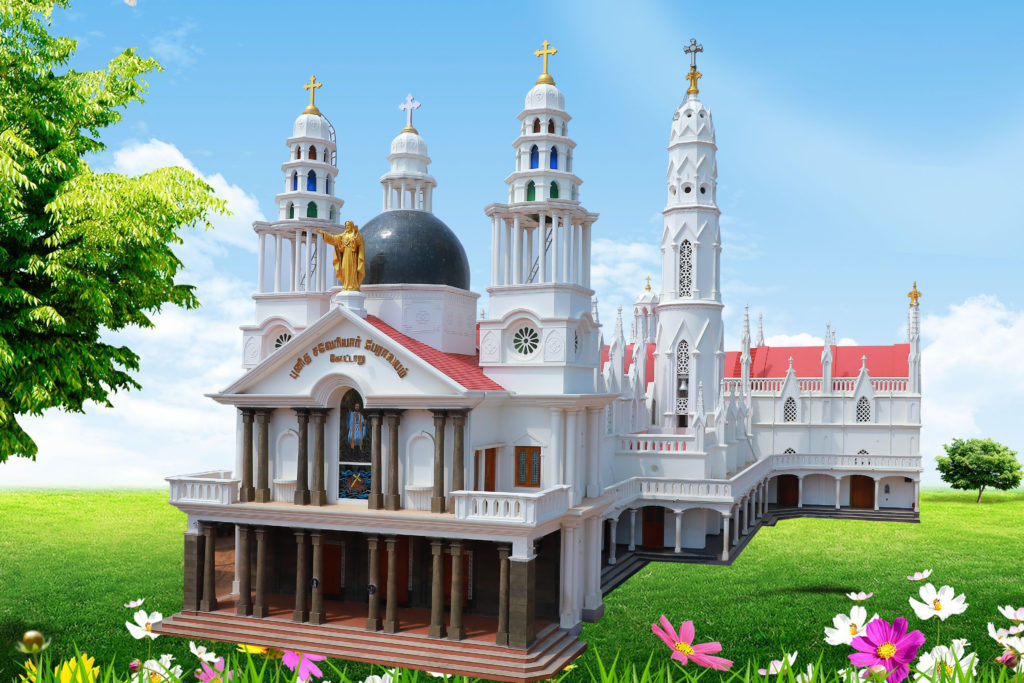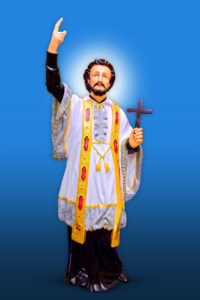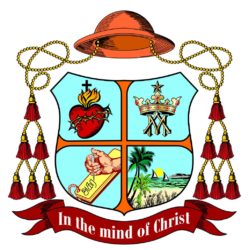CATHEDRAL

St. Xavier’s Cathedral, Kottar.
Next to Goa, where the incorrupt body of St. Francis Xavier is kept, St. Francis Xavier’s Cathedral, Kottar, in the southern district of KanyaKumari, Tamil Nadu, India, is a centre of pilgrimage in honour of St. Francis Xavier, the greatest post apostolic missionary of the Church and the patron of the missions.
Though thousands of pilgrims throng this hollowed place through the year, over five hundred thousand people (5,000,00) from all over Tamil Nadu and Kerala flock to venerate the Saint during the novena days leading to the feast,- from November 24 to December 3.
Pilgrims from all walks of life and creed visit the Cathedral of St. Francis Xavier, Kottar, either to offer their petitions or to thank for the favours received through his intercession. His miraculous intervention in favour of his devotees has been so powerful at this Shrine that it has become almost proverbial to address him endearingly in Tamil ” Kettavaram tharum Kottattu Saveriar, meaning, Xavier of Kottar, is the grantor of all favours”.
KOTTAR
The Shrine of St. Francis Xavier as well as the ancient town of Kottar now in the municipal town of Nagercoil, the administrative Capital of the District of Kanyakumari, have historical traditions. The commercial and business centre of Nagercoil, is on the bank of the river ” Pazhayaru”, where the river makes a bend, turning towards the south to the sea. Hence the name “Kottaru” in Tamil meaning is the bend of the river. It was a town of importance in the first century of the Christian era when Ptolemy visited and gave it the appellation” Metropolis”. It is also honourably mentioned in periplus of the second century. Kottar, the southern capital of the Venad Kingdom, was also a cosmopolitan town embracing within its orbit people of many castes and creeds. Among the many people in Kottar there was also a colony of Chavalakars, a kin to the Paravars of Cape Comorin region. It was to teach them and their counterparts in Manappadu area, their faith and strengthen them in the Christian way of life that Francis Xavier came to the Southern coast from Goa.
FRANCIS XAVIER

In 1541, Francis Xavier , started his journey from Lisbon in Portugal to India and landed in Goa a year later. After few months of missionary work in Goa, he left for the southern coast. Soon after arriving in Manappadu in Thuthukudi diocese, Francis Xavier started the missionary work by instructing and strengthening them in Catholic faith. In 1544 Francis Xavier was found often in Travancore to protect and help the Christians of Cape Comorin regions who were driven away from their homes by Vadugars. – Under the leadership of Captain Vittal Rao, the Vijayanagar army marched to capture the Venad Kingdom. Pandian and Chola armies joined him. As the news of the Badaga armies marching reached Kottar area, people panicked and had to flee for their lives. Sensing the danger, Francis Xavier, living then in a hut in Kottar, rushed to an elevated area in Vadasery just two kilometers north of Kottar and stood like a colossus holding a cross. Frightened at the sight of a holy man holding a cross, the marauding army retreated heeding to his advice not to march forward. The origin of the Cathedral Church at Kottar begins here: Francis Xavier built a Chapel for Our Lady in the land gifted by the King and used to celebrate Mass there. From Kottar he walked the length and the breadth of the Coastal region instructing and baptizing over 10000 fishermen known as Arasars Mukkuvars from Puvar, now in the Archdiocese of Trivandrum in Kerala to Pallam.
KOTTAR CHURCH
Following the death of Francis Xavier in 1552, the Church at Kottar became a place of pilgrimage to the people of South India. According to Fr. Andreas Vaz, in charge of the mission from Cape Comorin-Kanyakumari- to Rajakkamangalam, in 1616 there was a cross in Kottar, a pagan town, which the Chrisitians erected in honour of Fr. Francis Xavier and placed his picture and it was commonly known as the Cross of Father, Master Xavier. In Tamil it was known as Saveriar Kurusady ( Mon. X.II P.591) In 1660, there was a Church dedicated to the Conversion of St.Paul at Kottar and Fr. Andreas Buseria S.J., was the Parish Priest in charge (Mon. Xav. 1 P.589). Fr. Buseria seems to have placed a picture either in the Church or at the Kurusady-Cappella- near the Church. Indeed, next to Goa, Kottar has been and is the most sacred shrine to Francis Xavier. Fr. Andreas Buserio S.J. used to celebrate the feast every year on the day of the death of Francis Xavier and many Christians from the coast gathered there for the feast.( M.X.II P. 591). Hence pilgrimage to Kottar Church is of no recent origin. It has an unbroken history of over 400 years. What attracted the people were the innumerable, well attested miracles that had taken place in Kottar. Many of these miracles are referred to in the bull of Canonization issued in 1623 by Pope Urban VIII. Popular among the miracles was the raising to life of a month old baby that had died and was carried to the cemetery for burial. The parents full of faith promised to name the child Francis, if it were to revive. To their great joy the child came back to life and the fame of this miracle spread all over the country. (Op.cit.P. 716, 630 etc.) Another miracle attributed to the saint and accepted for his canonization concerns an inland fisherman, Perumal Panical, a poet and a teacher who lived near Kottar Church. He knew the catechism well and ten years before the building of the church composed a poem in honor of the Holy Faith and Fr. Nicholas Spinola, superior of the Jesuit College in Kollam. Fr. Buserio tried in vain to convert him, thinking that he would make an ideal custodian and Kanakkapillai (headman) of the Church. 3 – 3 – In course of time Perumal contracted the dreadful disease of leprosy and it debilitated him. Despite various treatments his condition was deteriorating day by day. In desperation he prostrated in front of the picture of Francis Xavier praising him in poems and applying the oil, from the lamps burning in front of the Shrine, all over his body. He began to recover soon and completely cured of leprosy. Christened as Francis, he was later appointed Kanakkapillai (headman) of the church ( Mon.II P. 590,61). Long before Francis Xavier’s canonization it was known as Xavier’s Church- Saveriar Kovil in Tamil- and after his canonization, the Church should have been rebuilt and dedicated to him. In the beginning of the 17th century, the offerings in money and oil brought to this Church were so great that it was enough to maintain five other churches in the interior areas. But in the course of many wars that devastated these parts of the country, all five churches were destroyed. But the Church at Kottar survived the attacks due to the fact that it was not only the Christians but also the Hindus who protected this place of pilgrimage.
SHRINE OF OUR LADY
The present vaulted Shrine of Our Lady, said to be on the very spot where the chapel of Our Lady was built, was erected in 1865 when the Church of Kottar was enlarged and vaulted over. It is very small with just enough space to accommodate an altar on which enthroned an ancient statue of Blessed Virgin Mary in a wooden recedes. The floor of the Shrine is about two feet and a half below the ground level, attesting to the antiquity of the spot and to the care to keep it open as hollowed place by the great saint. In fact at the top of the recedes there is a little angel holding a scroll with an inscription in Tamil, ” Come and Worship at the place where his feet have touched. All the pilgrims that visit the Shrine throughout the year and the crowd that attend the feast celebration from November 24 to December 3, make it a point to visit and pray at the Shrine of Our Lady. Bishops and Priests are very particular to celebrate Mass at the Shrine. Many Hindu pilgrims, after their ritual bath, go around the Shrine a stated number of times in performance of their vows.
MARTYR DEVASAHAYAM
The Church of St. Francis Xavier acquired another glory, when in 1752, the mortal remains of the heroic Martyr Devasahayam were interred within its sanctuary. Neelakanda Pillai, an official at the court of King Marthanda Varma of Travancore, was converted to Christian faith by the gentle efforts of the captured Captain of the Dutch Navy, E. B.de Lannoy, then at the service of the King. 4 – 4 – Neelakanda Pillai was baptized as Devasahayam- Lazarus- by Fr. John Baptist Putari S.J. at Vadakankulam. The king was very furious at the news of his conversion and tried in vain to persuade him to reconvert. But Devasahayam was firm in his faith. Denounced as a traitor, Devasahayam suffered patiently imprisonment and torture for three long years. On the order of the King, he was dragged to Katttadimalai Aralvaimozhi, at the boundary between the Travancore and Pandya Kingdoms, and shot dead on January 14, 1752. His body was discovered by some Christians who brought it to Kottar to be interred in the sanctuary. The tomb of this heroic Servant of God, Whose beatification ceremony took place in the grounds of Carmel Higher Secondary School, Nagercoil on 02-12-2012 is also a place of pilgrimage.
ST. FRANCIS XAVIER’S CATHEDRAL
From a Kurusady in the sixteen century, the Church of the Conversion of St. Paul which later became the Church of Francis Xavier, has undergone many renovations and additions. In 1865, the Church of Kotttar was enlarged with the addition of Cruciform wings and the present sanctuary and vaulted over. In the same year the Shrine of Our Lady was renovated and vaulted over. On 1930, thanks to the recommendation of the saintly Bishop Aloysius Maria Benziger OCD of Kollam, the Southern part of the Kollam diocese was bifurcated to form the new diocese of Kottar with Msgr. Lawrence Pereira as its first bishop. The Church of St. Francis Xavier and the Rectory became the Cathedral and the residence of the new Bishop. It continued as Bishop’s Residence until it moved to the present location. In 1942, in commemoration of the fourth centenary of the arrival of St. Francis Xavier in India, a beautiful tower was erected to the Saint in the Cathedral premises, as well as the Grotto to our Blessed Mother and a small Shrine to St. Ignatius, who had sent him to India. The pretty statue that adorns the main altar is said to have been brought from Goa. There is also a major relic of the Saint which is exposed to the veneration of the pilgrims during the feast days. The Cathedral acquired many styles of architectures. The old church and the vaulting were Romanesque, the extensions and the exterior are Gothic, while the fine stone Mandapam ( Lobby or Vestibule) in front is purely Indian. The entire church presents an imposing and pleasing appearance and a look of greatness.
Further renovation of the cathedral took place during the year 2017, with extension in the place where the mandapam existed and with two uniform towers built. The renovated Cathedral was blessed by Bishop Nazarene Soosai on 18th November 2017.
FEAST OF ST. FRANCIS XAVIER
The annual feast of St. Francis Xavier is being celebrated every year from November 24 till December 3, with great piety and fanfare. Each year the number of pilgrims increases by leaps and bounds and the District Administration declares a public holiday for the district of Kanyakumari, on December 3. It is one of the few Christian festivals in India that enjoys a public holiday declared by the secular government. 5 – 5 – All the nine days of the feast are being celebrated by various groups of people of all creeds which include government employees, teachers, local merchants and transport corporation workers and so on. One of the highlights of the ten-day celebration is the grand Car procession with the statues of the Blessed Virgin Mary and St. Francis Xavier. The honour is always given to the Blessed Mother, decked with rich jewels and ornaments, offered in thanksgiving by the devotees. Men and women, including Hindus, prostrate in front of the Cars in observance of their vows and penance. The Car procession, a remnant of the Hindu custom, attracts thousands of people all the final three days of the feast.
